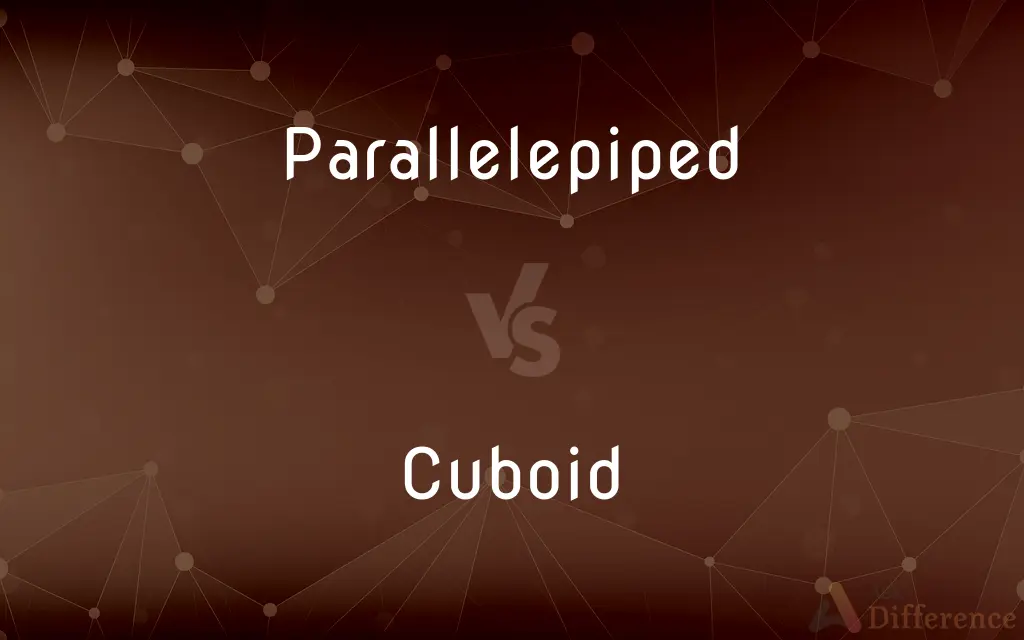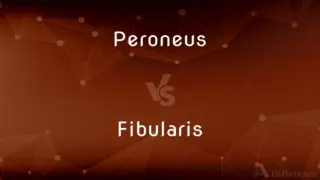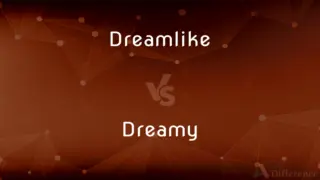Parallelepiped vs. Cuboid — What's the Difference?
Edited by Tayyaba Rehman — By Maham Liaqat — Updated on March 28, 2024
A parallelepiped is a six-faced figure with each face a parallelogram, while a cuboid is a rectangular prism with six rectangular faces, two of which are squares.

Difference Between Parallelepiped and Cuboid
Table of Contents
ADVERTISEMENT
Key Differences
Parallelepiped and cuboid are both three-dimensional geometric figures, but they differ in the shapes of their faces and their angular relationships. A parallelepiped is characterized by faces that are parallelograms, meaning opposite faces are parallel and equal in area, but not necessarily right-angled. This allows for a parallelepiped to have a more varied shape, including oblique angles. A cuboid, on the other hand, is a more specific type of parallelepiped where all angles are right angles, and each of its faces is a rectangle. Essentially, a cuboid is a type of parallelepiped but with the additional constraint that all its interior angles are 90 degrees, making it a special case with more symmetry.
In terms of edges, both a parallelepiped and a cuboid have twelve edges, but in a cuboid, opposite edges are not only parallel but also equal in length, and the faces are rectangular (with a special case being all squares, which would make it a cube). The angles between the edges of a cuboid are always right angles, whereas the angles in a parallelepiped can vary, providing a wider range of shapes.
From a spatial perspective, parallelepipeds can encompass a wider variety of forms, including those that are skewed, as long as opposite faces are parallel. Cuboids offer a sense of uniformity and regularity, making them common in everyday life, where boxes and rooms typically resemble cuboids due to their perpendicular edges and flat surfaces.
While both shapes are used in various fields of study, including mathematics, physics, and engineering, their properties and applications can differ significantly. Parallelepipeds are often used in more complex geometrical and physical problems, such as in the study of vectors and crystallography, where the angles and proportions of the sides matter. Cuboids are frequently encountered in more practical, everyday calculations, like determining the volume of containers or rooms.
Comparison Chart
Faces
6 faces, each a parallelogram
6 faces, each a rectangle
ADVERTISEMENT
Angles
Angles between edges can be oblique
Angles between edges are right angles
Edges
12 edges, opposite edges are parallel
12 edges, opposite edges are parallel and equal in length
Special Characteristics
Can have skewed shape due to varied angles
Always has a rectilinear shape due to right angles
Applications
Used in complex geometry, physics, and crystallography
Common in everyday life, architecture, and simple geometry
Compare with Definitions
Parallelepiped
A six-faced figure with each face a parallelogram.
The crystal structure of many minerals forms natural parallelepipeds.
Cuboid
A prism with six rectangular faces.
The room was shaped like a perfect cuboid, making it easy to calculate its volume.
Parallelepiped
Used in vector calculus to illustrate concepts.
We used a parallelepiped to demonstrate the cross product of vectors.
Cuboid
Represents boxes and containers in real life.
The storage boxes are cuboids, maximizing space efficiency.
Parallelepiped
Represents a class of polyhedra with parallel opposite faces.
The geometry class studied parallelepipeds in their section on polyhedra.
Cuboid
A special case of parallelepiped with right angles.
A cube is a cuboid where all faces are equal squares.
Parallelepiped
A geometric figure with opposite faces parallel and equal.
Parallelepipeds can be skewed, not possessing any right angles.
Cuboid
Common in architecture and design.
The architect designed the building as a series of interconnected cuboids.
Parallelepiped
Can vary widely in shape.
The toy blocks were designed as parallelepipeds to introduce children to complex shapes.
Cuboid
Used in teaching basic geometry.
Elementary students learn about volume and surface area using cuboids.
Parallelepiped
In geometry, a parallelepiped is a three-dimensional figure formed by six parallelograms (the term rhomboid is also sometimes used with this meaning). By analogy, it relates to a parallelogram just as a cube relates to a square.
Cuboid
(Anatomy) A tarsal bone on the outer side of the foot in front of the calcaneus and behind the fourth and fifth metatarsal bones.
Parallelepiped
A solid with six faces, each a parallelogram and each being parallel to the opposite face.
Cuboid
In geometry, a cuboid is a convex polyhedron bounded by six quadrilateral faces, whose polyhedral graph is the same as that of a cube. While mathematical literature refers to any such polyhedron as a cuboid, other sources use "cuboid" to refer to a shape of this type in which each of the faces is a rectangle (and so each pair of adjacent faces meets in a right angle); this more restrictive type of cuboid is also known as a rectangular cuboid, right cuboid, rectangular box, rectangular hexahedron, right rectangular prism, or rectangular parallelepiped.
Parallelepiped
(geometry) A solid figure, having six faces, all parallelograms, all opposite faces being similar and parallel.
A cuboid is a rectangular parallelepiped.
Cuboid
Having the approximate shape of a cube.
Parallelepiped
A prism whose bases are parallelograms.
Cuboid
(Mathematics) A rectangular parallelepiped.
Parallelepiped
A prism whose bases are parallelograms
Cuboid
Of the shape of a cube.
Cuboid
(anatomy) The cuboid bone.
Cuboid
(geometry) A parallelepiped having six rectangular faces.
Cuboid
Cube-shaped, or nearly so; as, the cuboid bone of the foot.
Cuboid
A rectangular parallelepiped
Cuboid
Shaped like a cube
Common Curiosities
What practical applications do cuboids have?
Cuboids are used in architectural design, storage solutions, and anywhere a rectangular box shape is practical for use or construction.
Can a cube be considered a type of parallelepiped?
Yes, a cube is a special case of both a parallelepiped and a cuboid where all faces are squares.
How do you calculate the volume of a parallelepiped?
The volume of a parallelepiped can be calculated using the scalar triple product of vectors representing its edges.
Is a square prism the same as a cuboid?
Yes, a square prism, where the base is a square, is a type of cuboid.
Can the volume of a cuboid be calculated the same way as a parallelepiped?
Yes, for both, the volume is the product of the lengths of its edges, but cuboids simplify to length × width × height due to right angles.
What distinguishes a parallelepiped from a general polyhedron?
A parallelepiped is a specific type of polyhedron with parallel, equal opposite faces, while polyhedra can have various shapes and face types.
How does the complexity of shapes affect their classification as parallelepiped or cuboid?
The more complex the angles and relationships between faces, the more likely a shape is to be classified as a parallelepiped; cuboids are defined by their simplicity and right angles.
Are parallelepipeds always solids?
Yes, parallelepipeds are three-dimensional solid figures defined by their geometric properties.
Can parallelepipeds have right angles?
While parallelepipeds can have right angles, not all of them do; the lack of right angles distinguishes some parallelepipeds from cuboids.
Why are parallelepipeds important in physics?
Parallelepipeds are used in physics for analyzing vector components, forces, and stresses in three dimensions, particularly in materials science.
Share Your Discovery

Previous Comparison
Peroneus vs. Fibularis
Next Comparison
Dreamlike vs. DreamyAuthor Spotlight
Written by
Maham LiaqatEdited by
Tayyaba RehmanTayyaba Rehman is a distinguished writer, currently serving as a primary contributor to askdifference.com. As a researcher in semantics and etymology, Tayyaba's passion for the complexity of languages and their distinctions has found a perfect home on the platform. Tayyaba delves into the intricacies of language, distinguishing between commonly confused words and phrases, thereby providing clarity for readers worldwide.
















































